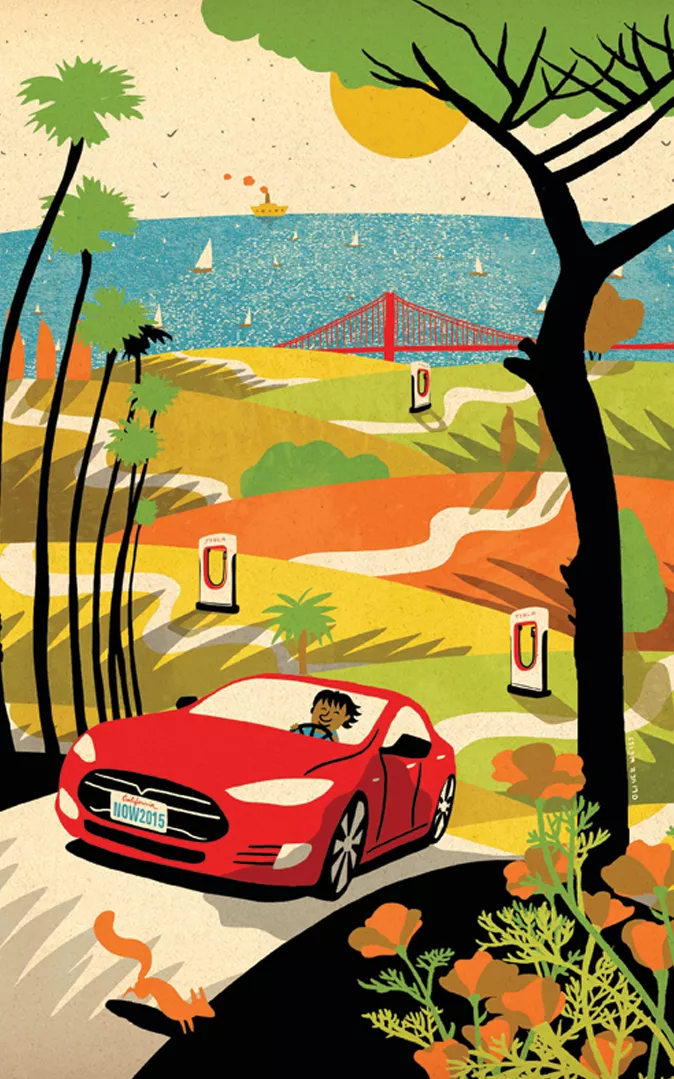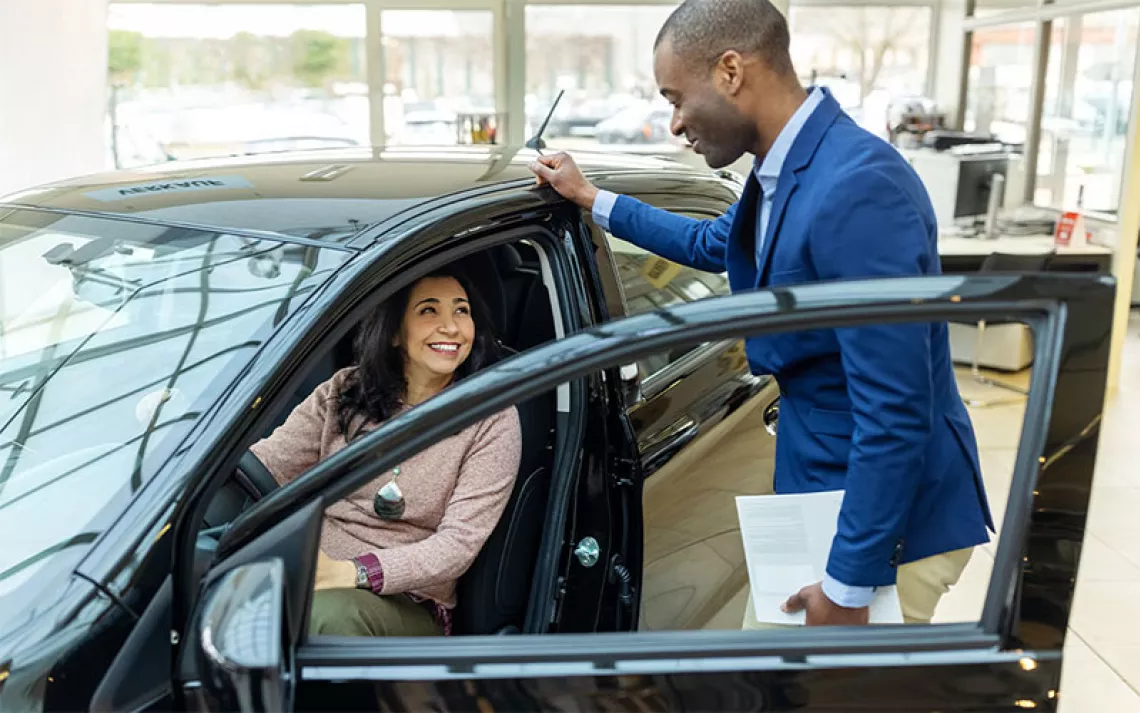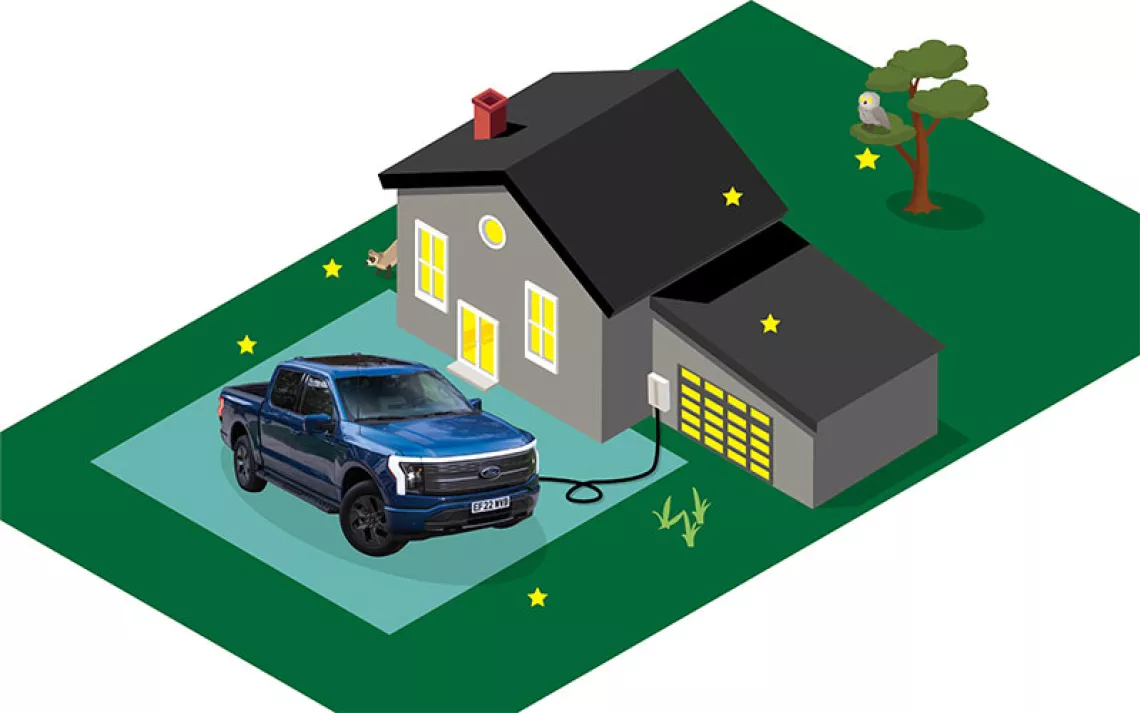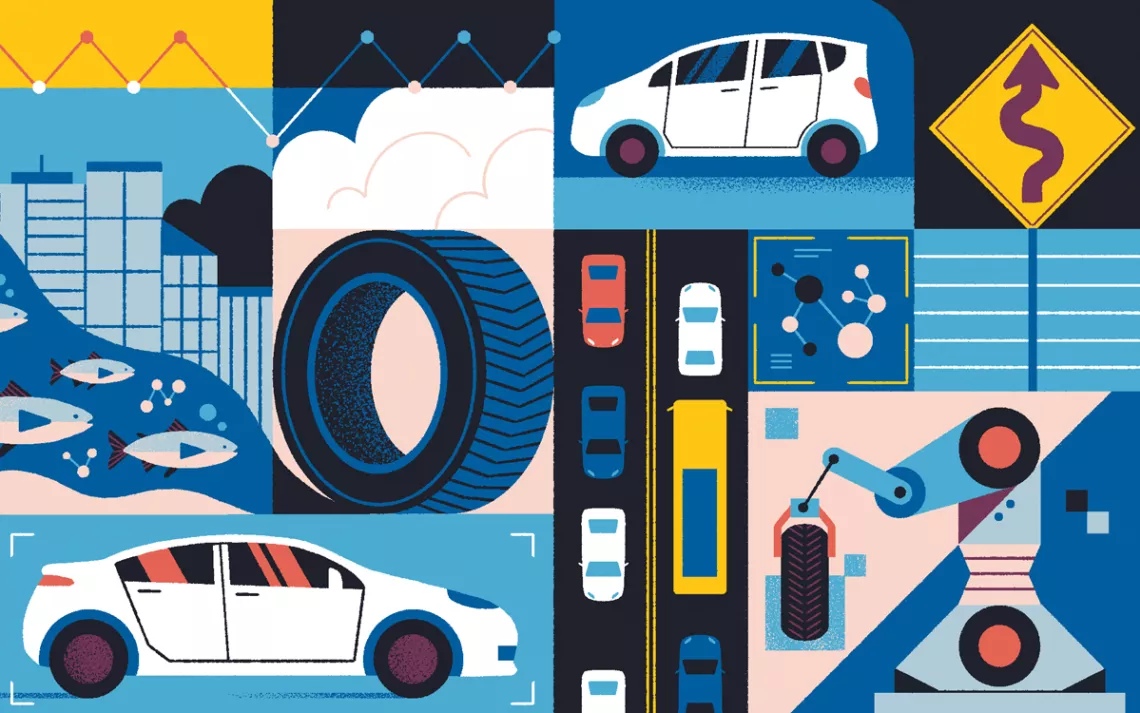Electric Vehicles Go the Distance with Fast Charging
Now that electric cars can go just as far as gasoline-powered models, the map opens up

Tesla has installed a network of electric-vehicle "superchargers" around the United States.
|Illustrations by Oliver Weiss
I'M DRIVING 550 MILES in three days, all by myself, mainly for the fun of it—and I'm not an environmental villain. Behind the wheel of a borrowed bright-red electric Tesla Model S, I click off the miles as I head south from the San Francisco Bay Area on Interstate 5 through California's San Joaquin Valley, feeling virtuous because my tailpipe spews no pollution.
I can't call my Tesla "zero polluting," because the electricity its batteries use comes from somewhere. But in my case, that somewhere is Pacific Gas & Electric Company's grid, one of the least fossil-fuel dependent in the United States. More than half of PG&E's power comes from solar, wind, hydro, and nuclear (which has its own host of problems); natural gas accounts for about a quarter; coal, less than 10 percent. Ever since then-NASA climatologist James Hansen testified in 1988 before the U.S. Senate that global warming had begun, those of us who grew up loving road trips, the longer and more serendipitous the better, have had to deal with climate guilt. As my super-silent $86,000 Tesla swoops down the interstate, I wonder, can the Great American Road Trip make a comeback?
I'm taking a route I've wanted to do for years: down the San Joaquin, west on winding, two-lane California Route 41 through the Coast Range to the Pacific Ocean, then north on U.S. 101 with a stop at Pinnacles National Park for some hiking (an EV in a national park? Yes!). The trip is practical in an all-electric car because my all-wheel-drive Model S 85D has a range of 270 miles (most EVs can travel 80 to 100 miles before needing to be recharged), and Tesla has installed an extensive network of direct-current (DC) fast-chargers—what the company calls "superchargers"—around the country. (A plug-in hybrid like the Chevrolet Volt could do the trip, of course, but it would mainly rely on its gasoline-powered engine.) My Tesla's battery can be refilled to 80 percent capacity in about half an hour; wait another half hour and the battery will fully recharge. So that's about 200 miles of driving between 30-minute rest stops. Drop that to 150 miles if you don't want to bite your nails from "range anxiety"—the electric-vehicle driver's fear of being stranded without juice far from an electrical outlet—and the process takes roughly the same amount of time as stopping to refuel a gas-powered car, stretch your legs, and grab a quick meal. A trip like this is possible without using fast-chargers, but recharging at the slower, public charging stations (most of which have 240-volt alternating-current outlets, like those used by an electric clothes dryer) would take several hours at each stop.
Electric-vehicle drivers get by perfectly well most of the time without fast-charging networks. That's because most drivers travel fewer than 40 miles per day, well within the range of every EV on the market. Plus, most electric-car drivers charge their cars overnight at home, and, if they're lucky, at an EV-friendly workplace or a charger-equipped mall while running errands. Tesla knows this, of course. And so do Nissan, BMW, and Volkswagen, which are following Tesla's lead in developing quick-charge networks. Fast-chargers are being installed to combat range anxiety. In a 2013 Union of Concerned Scientists survey, more than 50 percent of respondents said that range was the main reason they would not consider purchasing or leasing a plug-in car. Drivers may not really need a long-distance EV, but they may think they do. Besides, if you've recently spent $106,000 for a top-of-the-line Tesla, or even $30,000 on a Leaf (which can drop to around $20,000 with federal and state incentives), the last thing you want to hear is that you can't drive your shiny new set of wheels whenever and wherever you want. It's similar to the freedom-of-the-road mentality that persuaded so many mall-hopping Americans to buy gas-guzzling sport utility vehicles in the 1980s and 1990s. You may never actually drive 300-mile stretches of interstate (or hop boulders on the Rubicon Trail), but you like to know that you can.
- I'm driving a car that emits no pollution, solar panels have replaced a fossil fuel power plant, and the California coast is as stunning as ever.
Range is hardly on the minds of the couple I meet at Tesla's Harris Ranch facility on Interstate 5 charging their bright-red Tesla with greyhound Zoe resting comfortably on her dog bed in the back. They drive the 1,100 miles between Santa Fe, New Mexico, and San Francisco several times a year and couldn't be happier—the fact that superchargers dispense electricity for free to Tesla drivers is a key benefit. Tesla has installed seven supercharger stations along the couple's route, with the longest gap of 147 miles between stations in Flagstaff and Kingman, Arizona. (Not wanting to chance a 205-mile run from Santa Fe to Tesla's Gallup, New Mexico, supercharger, they topped off with a slow charge in Albuquerque, 60 miles after leaving home.)
For me, lack of range anxiety means I can drive my rocket-ship-powerful (0 to 60 in 4.4 seconds!) Model S like a bat out of hell without worrying about depleting the battery or offending James Hansen too much. As with any vehicle, driving at 55 miles per hour is about 20 percent more efficient than driving at 70 miles per hour. But try driving below 75 miles an hour on Interstate 5 (posted speed limit: 70) and you risk getting shoved off the road by a Prius hell-bent for L.A. When I forget to pull my foot off the accelerator after passing a car on Route 41 west of Harris Ranch, I glance down and realize I'm doing 102 miles per hour—near the junction where, in 1955, James Dean crashed his Porsche 550 Spyder, no less. No worries: The eight charging stalls in Atascadero are only 82 miles from the six at Harris Ranch; according to my Tesla's calculations, I wantonly used 121 "battery miles" to cover that distance but still have 133 miles available. When I arrive, one Tesla owner is napping in his seat while his car charges, and another pulls in and quickly heads across the street to run errands at a shopping center. I plug in (the filler's connector, as sleek as anything conceived by Apple, senses my car and electronically pops open the charge-port door), make sure the port is pulsating a green glow to indicate that the battery is charging, and stroll down the street to a Starbucks.
TESLA HAS INSTALLED 419 SUPERCHARGER stations to date and has partnered with another 2,300 locations (mainly hotels) across the United States to offer its drivers even more charging options. Since it offers the only all-electric vehicle suited to long-distance driving, Tesla is the farthest along with a long-distance fast-charging network. But other EV makers are rushing to catch up. In January, BMW and VW teamed up with the company ChargePoint to begin installing 100 fast-chargers on two heavily traveled corridors—Washington, D.C., to Boston and San Diego to Portland, Oregon. Spaced 50 or so miles apart, the chargers should "make it easy for drivers to choose electric mobility," says Robert Healy, BMW's head of EV infrastructure. Nissan's No Charge to Charge program, which began in 10 cities in 2013 and is being expanded to 15 more this year, offers Leaf owners free charging for two years at participating stations, many of which include fast-chargers. (Prices at fee-based stations vary, but fast charges can cost less than $10 per session.) Nissan has about 800 of its fast-chargers installed around the country and plans to double that figure by 2016. Charging network NRG is also expanding its fast-chargers nationwide. With EV sales growing more slowly than hoped because of low gas prices and the public's perception of range limitations, the Nissan and VW/BMW programs, like Tesla's, are efforts to get the proverbial butts in seats. No Charge to Charge has been popular, helping the Leaf become the biggest-selling plug-in car in the United States; more than 76,000 have been sold since 2010. The expansion of public charging "spurs range confidence and additional Leaf sales," says Brendan Jones, director of the carmaker's electric vehicle sales.
GM, Ford, Nissan, and VW are racing to offer EVs that travel 200 or more miles on a charge like the Tesla Model S. In the meantime, for most electric vehicles, fast charging is more appropriate for regional trips than long-distance ones. A Tesla driving between San Francisco and Los Angeles can make the 382-mile trip with two 30-minute stops at superchargers. Try that in an EV with an 80- or 90-mile range, and even with fast-charging facilities along the route, the half dozen or so recharging stops you'd need to make would satisfy only the truly devoted or masochistic. But longish regional trips, such as the 120 miles between San Diego and downtown L.A. (or the 50 miles between Orange County and L.A.), suddenly become attractive for a Nissan Leaf or Chevrolet Spark EV driver, who can anticipate a single 30-minute recharging stop every 60 miles or so.
Confusing the push for fast charging is the fact that different carmakers use different charging standards. Any electric car can be plugged into a three-prong outlet or one of the approximately 12,000 240-volt charging stations found throughout the United States, but if you want a fast charge, it's like the battle between Apple, Android, and Microsoft out there. Nissan, Kia, and Mitsubishi rely on the CHAdeMO standard popular in Japan (with a $450 adapter, Tesla models can use it, too). BMW's i3, Volkswagen's e-Golf, and the Chevrolet Spark EV use the newer Combined Charging System, which includes fast- and slow-charging setups in one device. Tesla's system is exclusive, though the company has offered to share its technology with other carmakers. Whether one of these three standards prevails or a newer standard that works with any existing one supplants them all will be determined by the cleverness of a competitive market.
I'M A DEFENDER OF ROAD TRIPS for their own sake—I have some free time and, hey, there's a road—but my itinerary includes two more destinations after James Dean's junction, one of which is the sleepy old-California beach town of Cayucos, where I stay at an appropriately retro one-story motel strolling distance from the beach. Midweek in the off-season, there's not much to do in Cayucos but take off your shoes and walk on the beach, but, of course, that's all you really want to do in a sleepy beach town anyway. From Cayucos State Beach, I ponder the three 450-foot-high smokestacks of the Morro Bay Power Plant, six miles across Estero Bay. Built in the early 1950s, the power plant sits immediately across the street from the Pacific, a reminder of a time when, even though landmark environmental laws had yet to be enacted, Californians probably should have known better. The plant, which burned coal originally and then natural gas, was shut down last year, no longer competitive and unable to meet current environmental standards. By continually pulling water for cooling from the Morro Bay National Estuary, the plant was creating havoc for marine life. The power source for the area has shifted to a new solar array inland. With sand squeezing between my toes, I become fuzzily optimistic: I'm driving a car that emits no pollution, solar panels have replaced a fossil fuel power plant, and the California coast is as stunning as ever. Maybe the future is doable after all.
From the Pacific coast, I return the 21 miles to the Atascadero supercharger and refresh both the Tesla ("263 miles available," the dashboard gauge tells me) and myself (at the same Starbucks), ready in 30 minutes for my next leg, to Pinnacles National Park. Few events are more American than a road trip to a national park. While Tesla's fast-charging network is more oriented to long-distance roadways than remote destinations, Pinnacles is only 95 miles from the Atascadero supercharger and another 47 miles from the Gilroy supercharger, even when I drive the circuitous "back way" to the eastern entrance, an empty two-laner that straddles the San Andreas Fault through cattle country. Once there, I spot a classic black 1957 Chevy Bel Air and park next to it so I can take a photo. Its owner is unimpressed. He and his ride are too cool for school, apparently.
I wander through the dark caves and around the ragged volcanic formations of Pinnacles over a long afternoon, and then, on my way to the beach at Santa Cruz, I drive a 12-mile detour to the Gilroy supercharger for a second visit. (I stopped here at the start of my journey, having driven the Model S only 47 miles. Tesla suggested I stop off at an available supercharger whenever I was near one.) The four other Tesla drivers charging at Gilroy go about their business. I had expected a "clubbier" feel to the endeavor, but with half of all Teslas reportedly sold in California, the cars are relatively common in the Golden State. (As one wag quipped in an online comment to the Los Angeles Times, "The Tesla has become the Camry of the L.A. Basin.")
I'm only 84 miles from where I will return the Tesla, but with 262 battery miles available, and expertise in what I can do with them, I dawdle. I take a slow, windy route up and over the Santa Cruz Mountains. I mosey along Santa Cruz's breathtakingly scenic West Cliff Drive at sunset. The next morning, I head up Highway 1, fighting the urge to speed on my very last segment of coastal highway. I turn east, driving back up into the Santa Cruz Mountains and then down toward the sprawl of Silicon Valley. When I close in on Palo Alto, the Tesla's navigation system prompts me to head directly to Interstate 280, the quickest route. I turn it off, crank up the radio, and head my Tesla down Portola, Alpine, and Arastradero Roads, winding two-lane favorites of cyclists and open-air motorists in the area. After all, it's a road trip.
This article has been corrected.
An EV for Millions of Drivers
Factoring in daily commute, access to charging, frequency of long-distance trips, and budget (including federal and state incentives, which can top $10,000 depending on location), there are plug-in vehicles to fit millions of new-car drivers' needs. The Sierra Club's Pick a Plug-In quiz will help you sort through the more than two dozen all-electric and plug-in hybrid electric vehicles on the market today. Click to take the quiz and get more information about plug-in cars. Here are examples of drivers and some EVs that meet their needs.
 Gloria (Cambridge, MA)
Gloria (Cambridge, MA)
Daily driving: 7-mile round-trip commute; local errands
Distance driving: lots of long family trips
Charging: private driveway near an outlet but no garage
Passengers: family of four
Budget: $30,000
EVs to consider: Chevrolet Volt, Ford Fusion Energi, Ford C-Max Energi, Toyota Prius Plug-in
 Sunil (St. Paul, MN)
Sunil (St. Paul, MN)
Daily driving: 22-mile round-trip commute
Distance driving: usually travels by air; willing to rent a car for long trips
Charging: outlet in his condo's garage
Passengers: solo driver
Budget: $55,000
EVs to consider: BMW i3, Ford Focus Electric, Nissan Leaf, Smart Fortwo Electric, Mercedes-Benz B-Class Electric Drive
 Lucia (Atlanta, GA)
Lucia (Atlanta, GA)
Daily driving: 50-mile round-trip commute
Distance driving: has second car, so not an issue
Charging: access to an outlet at home, at work, and in her community
Passengers: family of three
Budget: $25,000
EVs to consider: Ford Focus Electric, Kia Soul EV, Nissan Leaf
 Vanessa (Oakland, CA)
Vanessa (Oakland, CA)
Daily driving: 8-mile round-trip commute
Distance driving: regular 50-mile trips to visit family
Charging: parking with access to outlet
Passengers: solo driver
Budget: $75 to $190 per month (financing used or leasing new)
EVs to consider: Chevrolet Spark EV, Fiat 500e, Nissan Leaf, Smart Fortwo Electric
 David (Seattle, WA)
David (Seattle, WA)
Daily driving: no commute
Distance driving: regular 175-mile trips to visit daughter
Charging: private garage with outlet and rooftop solar panels
Passengers: family of two
Budget: $75,000
EVs to consider: BMW i3, Tesla Model S, Mercedes-Benz B-Class Electric Drive
 Sunwoo (Ann Arbor, MI)
Sunwoo (Ann Arbor, MI)
Daily driving: 25-mile round-trip commute
Distance driving: occasional long-distance trips (and willing to rent a car)
Charging: private garage with outlet
Passengers: family of six, plus friends and gear
Budget: $70,000
EVs to consider: Tesla Model X all-electric SUV *, Chrysler Town & Country plug-in hybrid minivan **
* likely available late 2015
** likely available 2016
How Green Is My EV?
A plug-in vehicle is much cleaner than one that runs on oil, but it is as clean as the power it relies on. In the hydro-heavy Pacific Northwest, your EV shines; in the coal-dependent Midwest, not as much (but it's still a strong choice). Of course, if you power your EV from your own rooftop solar panels, you are as good as gold.
The Sierra Club and other environmental groups and academics have done the math and found that even in places with a lot of dirty electricity sources, electric vehicles are cleaner than conventional vehicles, and keep getting cleaner as utilities shift to more renewable sources of power.
The Union of Concerned Scientists found that 60 percent of U.S. residents live in regions where an EV produces fewer global warming emissions than even the most efficient gasoline-electric hybrid. Click to read more about your region's power sources.
 The Magazine of The Sierra Club
The Magazine of The Sierra Club



